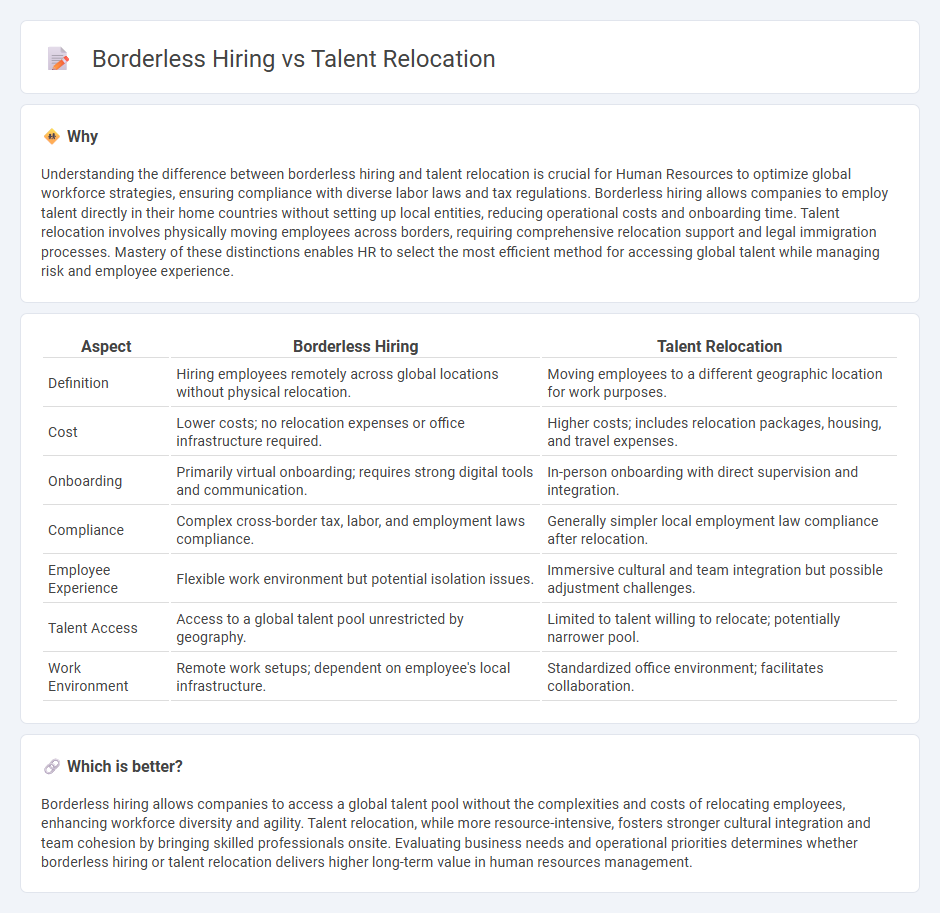
Borderless hiring enables companies to access global talent pools without geographical restrictions, reducing time-to-hire and increasing workforce diversity. Talent relocation focuses on moving selected employees across borders to align skills with strategic business needs while ensuring compliance with immigration laws. Discover how borderless hiring and talent relocation can transform your human resources strategy.
Why it is important
Understanding the difference between borderless hiring and talent relocation is crucial for Human Resources to optimize global workforce strategies, ensuring compliance with diverse labor laws and tax regulations. Borderless hiring allows companies to employ talent directly in their home countries without setting up local entities, reducing operational costs and onboarding time. Talent relocation involves physically moving employees across borders, requiring comprehensive relocation support and legal immigration processes. Mastery of these distinctions enables HR to select the most efficient method for accessing global talent while managing risk and employee experience.
Comparison Table
| Aspect | Borderless Hiring | Talent Relocation |
|---|---|---|
| Definition | Hiring employees remotely across global locations without physical relocation. | Moving employees to a different geographic location for work purposes. |
| Cost | Lower costs; no relocation expenses or office infrastructure required. | Higher costs; includes relocation packages, housing, and travel expenses. |
| Onboarding | Primarily virtual onboarding; requires strong digital tools and communication. | In-person onboarding with direct supervision and integration. |
| Compliance | Complex cross-border tax, labor, and employment laws compliance. | Generally simpler local employment law compliance after relocation. |
| Employee Experience | Flexible work environment but potential isolation issues. | Immersive cultural and team integration but possible adjustment challenges. |
| Talent Access | Access to a global talent pool unrestricted by geography. | Limited to talent willing to relocate; potentially narrower pool. |
| Work Environment | Remote work setups; dependent on employee's local infrastructure. | Standardized office environment; facilitates collaboration. |
Which is better?
Borderless hiring allows companies to access a global talent pool without the complexities and costs of relocating employees, enhancing workforce diversity and agility. Talent relocation, while more resource-intensive, fosters stronger cultural integration and team cohesion by bringing skilled professionals onsite. Evaluating business needs and operational priorities determines whether borderless hiring or talent relocation delivers higher long-term value in human resources management.
Connection
Borderless hiring leverages global talent pools, enabling organizations to access diverse skills without geographical constraints, while talent relocation involves moving selected employees to strategic locations to optimize business operations. Integrating borderless hiring with talent relocation strategies enhances workforce agility, promotes cultural exchange, and addresses regional skill shortages effectively. This synergy improves organizational competitiveness by aligning talent acquisition with global mobility trends and regulatory compliance.
Key Terms
**Talent Relocation:**
Talent relocation involves the strategic transfer of skilled employees across geographic boundaries to meet organizational needs, ensuring compliance with local immigration laws and optimizing workforce distribution. This approach supports business growth by enabling targeted talent placement in key markets while managing logistical challenges, including visa processing and cultural integration. Discover more about how talent relocation can enhance your global workforce strategy.
Expatriate Assignment
Expatriate assignments involve talent relocation where employees physically move across borders to work in a host country, often for a fixed period, ensuring direct cultural integration and business alignment. Borderless hiring eliminates geographic constraints by enabling remote work and global talent acquisition without requiring physical relocation, improving cost-efficiency and workforce flexibility. Explore our detailed insights to understand the strategic benefits and challenges of expatriate assignments compared to borderless hiring models.
Relocation Package
A relocation package typically includes expenses such as moving costs, temporary housing, and orientation support, making talent relocation a cost-intensive but structured approach compared to borderless hiring. Borderless hiring leverages remote work capabilities, reducing or eliminating relocation expenses while accessing global talent pools. Explore comprehensive strategies to optimize hiring costs and employee satisfaction through tailored relocation packages.
Source and External Links
Why Moving Talent is a Talent Acquisition Strategy - Talent relocation is a strategic approach that helps companies attract and retain top-tier candidates globally by offering comprehensive relocation services aligned with career and personal goals, thus enhancing recruitment and retention efforts in a competitive market.
Navigating the increasing complexities of talent mobility - Talent relocation has grown complex due to issues like tax, risk, and global employee experience, requiring agile strategies that accommodate remote and hybrid work preferences while providing career development and cultural growth opportunities.
Why You Should Conduct a Talent Relocation Policy - Implementing a clear talent relocation policy offers employees security, supports workforce flexibility, outlines benefits and wage adjustments, and helps companies outperform competitors by appealing to modern workforce expectations.
 dowidth.com
dowidth.com